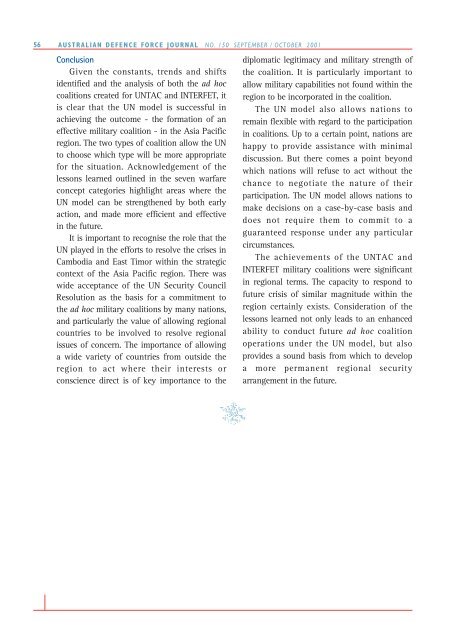ISSUE 150 : Sep/Oct - 2001 - Australian Defence Force Journal
ISSUE 150 : Sep/Oct - 2001 - Australian Defence Force Journal
ISSUE 150 : Sep/Oct - 2001 - Australian Defence Force Journal
Create successful ePaper yourself
Turn your PDF publications into a flip-book with our unique Google optimized e-Paper software.
56AUSTRALIAN DEFENCE FORCE JOURNAL NO. <strong>150</strong> SEPTEMBER / OCTOBER <strong>2001</strong>ConclusionGiven the constants, trends and shiftsidentified and the analysis of both the ad hoccoalitions created for UNTAC and INTERFET, itis clear that the UN model is successful inachieving the outcome - the formation of aneffective military coalition - in the Asia Pacificregion. The two types of coalition allow the UNto choose which type will be more appropriatefor the situation. Acknowledgement of thelessons learned outlined in the seven warfareconcept categories highlight areas where theUN model can be strengthened by both earlyaction, and made more efficient and effectivein the future.It is important to recognise the role that theUN played in the efforts to resolve the crises inCambodia and East Timor within the strategiccontext of the Asia Pacific region. There waswide acceptance of the UN Security CouncilResolution as the basis for a commitment tothe ad hoc military coalitions by many nations,and particularly the value of allowing regionalcountries to be involved to resolve regionalissues of concern. The importance of allowinga wide variety of countries from outside theregion to act where their interests orconscience direct is of key importance to thediplomatic legitimacy and military strength ofthe coalition. It is particularly important toallow military capabilities not found within theregion to be incorporated in the coalition.The UN model also allows nations toremain flexible with regard to the participationin coalitions. Up to a certain point, nations arehappy to provide assistance with minimaldiscussion. But there comes a point beyondwhich nations will refuse to act without thechance to negotiate the nature of theirparticipation. The UN model allows nations tomake decisions on a case-by-case basis anddoes not require them to commit to aguaranteed response under any particularcircumstances.The achievements of the UNTAC andINTERFET military coalitions were significantin regional terms. The capacity to respond tofuture crisis of similar magnitude within theregion certainly exists. Consideration of thelessons learned not only leads to an enhancedability to conduct future ad hoc coalitionoperations under the UN model, but alsoprovides a sound basis from which to developa more permanent regional securityarrangement in the future.
















